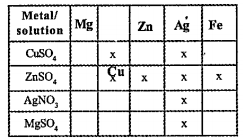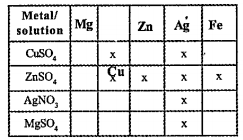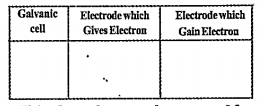Complete Solutions to EXAMPLE of chapter REACTIVITY SERIES AND ELECTROCHEMISTRY of Class 10 book with complete answers and questions
| Class 10 | CHEMISTRY |
| Chapter | REACTIVITY SERIES AND ELECTROCHEMISTRY |
| BODY BOOKS PUBLICATION | EXAMPLE |
| Number Of Questions | 100 |
| Academic Year | 2023-24 |
Which metal among magnesium, copper, gold, sodium and aluminium, loses its lus-tre at a faster rate?
View SolutionList the above metals in the decreasing order of their reactivity with air and thereby losing luster.
Magnesium, Sodium, Copper, Gold, Aluminum
View SolutionWhat happens to the Zn rod when dipped in copper sulfate solution?
View SolutionWhen `Zn` rod is dipped in `CuSO_4` solutions, `Zn` rod become blue. What is the reason for this?
View SolutionWhat is the reason for the change in intensity of the colour of `CuSO_4` solution?
View SolutionWhen `Zn` rod is dipped in `CuSO_4` solutions, intensity of colour of `CuSO_4` solution changes. Which is the metal that gets displaced here?
View SolutionWhat is more reactive Zn or Cu?
View SolutionOn the basis of the position of Zn and Cu in the reactivity series, can you explain why Cu had been displaced?
View SolutionOn the basis of position of `Zn` and `Cu` in reactivity series, when When `Zn` rod is dipped in `CuSO_4` solutions, Cu had been displaced. Isn't it due to the higher reactivity of zinc (Zn) when compared to copper (Cu)?
View SolutionWhen `Zn` rod is dipped in `CuSO_4` solutions, `Zn` rod become blue. Is this reaction oxidation or reduction? Why?
View SolutionWhen `Zn` rod is dipped in `CuSO_4` solutions, `Zn` rod become blue. What is the name of this reaction? Why?
View Solution`2` `Ag^(+1) NO_3^((...))` + `Cu^0` `→` `Cu^((...))(NO_3)_2^(-1)` + `Ag^((...))`. Complete this chemical equation by assigning oxidation numbers.
View SolutionWhich metal is oxidized in this case? Which metal is reduced? `Zn(S) + Cu^(2+) → Zn^(2+) + Cu(S)`
View SolutionWrite equations showing oxidation and reduction.
View SolutionWhich electrode has the ability to donate electrons in a cell constructed using these metals? `Zn and Cu`
View SolutionWhich one can gain electrons?
View SolutionIdentify the chemical reaction that takes place at the Zn electrode in a Daniel cell. Tick `√` the right one.
View SolutionWrite the chemcial equation for the reac-tion taking place at the Cu electrode.
View SolutionFrom the electrochemical series, Cu can displace Ag from silver nitrate solution
Represent the cell constructed with silver and copper electrodes
View SolutionNote down the reaction of Galvanic cell.
View SolutionDirection of flow of electrons in a galvanic cell constructed using `Cu` and `Ag`.
View SolutionWrite the reactions taking place at cathode and anode in cell constructed using `Ag` and `Cu`
View SolutionYou have used threee metals Zn, Cu and Ag. How many cells can be produced using these?
View SolutionComplete the Table 3.4 by writing anode and cathode in each. `Zn - Cu`, `Cu - Ag`, and `Zn - Ag`
View SolutionWhat are the substances obtained when electricity is passed through acidified wa-ter?
View SolutionWhat type of chemical changes happen when electricity is passed through brine solution?
View SolutionTo which electrodes are the positive ions attacted during electrolysis?
View SolutionTo which electrodes are the negative ions attracted?
View SolutionWhat changes happen to the ions which are attracted to cathode?
View SolutionWhat about the changes happening to the ions attracted to anode?
View SolutionWhich ion is attracted to the positive elec-trode (anode)?
View SolutionWhat is the chemical reaction taking place in the flask. Name the gas involved
View SolutionWhich is the gas liberated at the anode during electrolysis of water?
View SolutionWhich is the ion attracted to the cathode during electrolysis of sodium chloride solution?
View SolutionWhich is the metal deposited at the cathode during electrolysis of aqueous `AgCl`?
View SolutionThe solutions of `ZnSO4`, FeSO4, CuSO4` and `AgNO3` are taken in four different test tubes. Suppose, an iron nail is kept immersed in each one: In which test tube the iron nail under goes a colour change?, What is the reaction taking place here?
View SolutionThe ions which are attracted to the negative electrode are called?
View SolutionWhich metal is connected to the negative terminal of the battery?
View SolutionWhich metal is connected to the positive terminal of the battery?
View SolutionWhich solution is used as the electrolyte in Nelson's process?
View SolutionWhat happens to `Cu^(2+)` ions at the cathode? Complete the equation.
View SolutionWhat happened to the copper ions? Oxidation/Reduction?
View SolutionComplete the equations given below.
a) `H_(2)SO_(4)+Znrarr......`
b) `H_(2)SO_(4)+2NaOH rarr......`
c) `H_(2)SO_(4)+CaCO_(3)rarr......`
View SolutionFind out examples of chromium plating and extend the list
View SolutionCompare the electrolysis of molten potassium chloride and solution of potassium chloride. What are the pro cesses taking place at the cathode and the anode?
View SolutionYou are given a solution of `AgNO_3` , a solution of `MgSO_4` , a Ag rod and a Mg ribbon. How can you arrange a Galvanic cell using these? Write down the reactions taking place at the cathode and the anode.
View SolutionKeep two carbon rods immersed in copper sulphate solution.Then pass electricity through the solution: At which electrode does colour change occur anode or cathode?
View SolutionKeep two carbon rods immersed in copper sulphate solution.Then pass electricity through the solution: Is there any change in the blue colour of the copper sulphate solution?
View SolutionKeep two carbon rods immersed in copper sulphate solution.Then pass electricity thr-ough the solution: Write down chemcial equations for the changes occuring here.
View SolutionWhen acidified copper sulphate solution is electrolysed oxygen is obtained at the anode. What arrangements are to be made for this? Find the element deposited at the cathode.
View SolutionHow many Galvanic cells can be made by using the metals Ag, Cu, Zn and Mg. When Galvanic cells are made using the metals given, what will be the nature of reactions in each cell? (Reactivity: Mg gt Zn gt Cu gt Ag).
View SolutionHow many Galvanic cells can be made by using the metals Ag, Cu, Zn and Mg. When Galvanic cells are made using the metals given, what will be the nature of reactions in each cell? (Reactivity: Mg gt Zn gt Cu gt Ag).
View SolutionTake cold water and Hot water in two test tubes, Add one or two drops of phenolphthalein in it Drop equally sized Mg ribbon in it: In which test tube pink colour occurred sharply?
View SolutionTake cold water and Hot water in two test tubes,Add one or two drops of phenolphthalein in it Drop equally sized Mg ribbon in it: Why did pink colour appear in that test tube so early?
View SolutionTake cold water and Hot water in two test tubes,Add one or two drops of phenolphthalein in it Drop equally sized Mg ribbon in it: Which gas evolved out from both test tubes?
View SolutionTake cold water and Hot water in two test tubes,Add one or two drops of phenolphthalein in it Drop equally sized Mg ribbon in it: Write balanced equation for the above mentioned reaction.
View SolutionCut a small sodium metal piece into two, watch it: What change occurred on the surface of sodium metal?
View SolutionCut a small sodium metal piece into two, watch it: Write one word for the process of this type of decomposition.
View SolutionCut a small sodium metal piece into two, watch it: Write down the equations for this.
View SolutionTake equal quantities of dil HCI in four test tubes. Drop Mg, Zn, Fe,Cu in each test tube. Watch carefully: Arrange metals in decreasing order or reactivity.
View SolutionTake equal quantities of dil HCI in four test tubes. Drop Mg, Zn, Fe,Cu in each test tube. Watch carefully: Write balanced equation for each reaction.
View SolutionSome metals and metallic compounds are given in the table. If the metal substitute the metal in the compound, put a tick mark in the corresponding column and otherwise a cross mark in the column. Write down correct answer based on the table given below.
 : Correct the table if necessary.
: Correct the table if necessary.
View SolutionSome metals and metallic compounds are given in the table. If the metal substitute the metal in the compound, put a tick mark in the corresponding column and otherwise a cross mark in the column. Write down correct answer based on the table given below.
 : Write down balanced equations for all the true sign given in the table.
: Write down balanced equations for all the true sign given in the table.
View SolutionDraw maximum number of Galvanic cell using substance given in the table.
 Complete the table based on the figures drawn.
Complete the table based on the figures drawn.

View SolutionDraw maximum number of Galvaniccell using substance given in the table.

: Write down the general names used for an electrode which gives electrons.
View SolutionDraw maximum number of Galvanic cell using substance given in the table.

Metals in that electrode in the reactivity series is ………………. (in the Top, Bottom)
View SolutionDraw maximum number of Galvanic cell using substance given in the table.
 : General name of the Electrode which accepts electron.
: General name of the Electrode which accepts electron.
View SolutionDraw maximum numberof Galvaniccell us ing substance given in the table.
 : Process of giving electron is………….
: Process of giving electron is………….
View SolutionDraw maximum numberof Galvaniccell us ing substance given in the table.
 : Process of Accepting electron is ………….
: Process of Accepting electron is ………….
View SolutionDraw any one of the Galvaniccell using substance given in the table.
 : Direction of the flow of Electron……………..
: Direction of the flow of Electron……………..
View SolutionDraw maximum number of Galvanic cell using substance given in the table.
 : Write down the balanced equation taking place in both electrodes.
: Write down the balanced equation taking place in both electrodes.

View SolutionTake Cupricchloride `(CuCI_2)` solution in a 'beaker. Dip two graphite rod in it. Pass 5V electricity through it: Why electricity passes through cupric chloride solution?
View SolutionTake Cupricchloride `(CuCI_2)` solution in a 'beaker. Dip two graphite rod in it. Pass 5V electricity through it: Which gas evolved out through positive electrode? How did you identify that gas?
View SolutionTake Cupricchloride `(CuCI_2)` solution in a 'beaker. Dip two graphite rod in it. Pass 5V electricity through it: Which gas evolved out through positive electrode? How did you identify that gas?
View SolutionTake Cupric chloride `(CuCI_2)` solution in a 'beaker. Dip two graphite rod in it. Pass 5V electricity through it: In which electrode oxidation and reduction takes place?
View SolutionTake Cupricchloride `(CuCl_2)` solution in a 'beaker.Dip two graphite rod in it. Pass 5V electricity through it: Write one word for the process of chemical change happening in a Electrolyte while passing Electricity?
View SolutionTake 25 ml water in a beaker and the pass electricity through it. Then add little sulphuric acid init: Why electricity didn't pass through pure water?
View SolutionTake 25 ml water in a beaker and the pass electricity through it. Then add little sulphuric acid in it: What happens when dil `H_2SO_4` is added?
View SolutionTake 25 ml water in a beaker and the pass electricity through it. Then add little sulphuric acid in it: Which type of ion formed more when sulphuric acid is added in water.
View SolutionTake 25 ml water in a beaker and the pass electricity through it. Then add little sul-phuric acid in it: Complete the equation of the Ionization of `H_2SO_4` `H_2SO_4rarr2H^+……………….`. ........................................................................................................................................................................ Based on the equation given below write down the correct answers. `2H^+ +.............+2H_2Orarr2H_3O^++SO_(4)^(2-)`
View SolutionTake 25 ml water in a beaker and the pass electricity through it. Then add little sulphuric acid in it: Complete the equation
View SolutionTake 25 ml water in a beaker and the pass electricity through it. Then add little sulphuric acid in it: What happens when dil `H_2SO_4` is added?
View SolutionTake 25 ml water in a beaker and the pass electricity through it. Then add little sulphuric acid in it: Which type of ion formed more when sulphuric acid is added in water.
View SolutionTake 25 ml water in a beaker and the pass electricity through it. Then add little sulphuric acid init: Why electricity didn't pass through pure water?
View SolutionTake 25 ml water in a beaker and the pass electricity through it. Then add little sul-phuric acid init: Which ion is having highest oxidation po-tential?
View SolutionTake 25 ml water in a beaker and the pass electricity through it. Then add little sulphuric acid in it: What happens when dil `H_2SO_4` is added?
View SolutionTake 25 ml water in a beaker and the pass electricity through it. Then add little sul-phuric acid init: Ions remain in the beaker after the elec-trolysis are …………….,……………
View SolutionTake 25 ml water in a beaker and the pass electricity through it. Then add little sulphuric acid in it: What happens when dil `H_2SO_4` is added?
View SolutionComplete the table based on the Electrolysis of molten sodium chloride.

View SolutionWrite down the reaction taking place in each electrodes and products formed in the electrolysis of sodium chloride solution.

View SolutionWhy is hydrogen formed at the cathode instead of sodium in electrolysis of aqueous sodium chloride?
View SolutionWrite one word for a solution undergoes chemical change when electricity passes through it.
View SolutionReaction is taking place in each electrodes in electrolysis of sodium chlorides solution. Write the name of the above process.
View SolutionWhich gas is bubbled on the surface of so-dium metal?
View SolutionWrite balanced equation of the reaction between sodium and water.
View SolutionWhat products occurs when Iron reacts with water vapour?
View SolutionLusture of magnesium disappeared fast when it placed in open space why?
View SolutionVerdigris formed on copper utensils after somedays why?
View SolutionLustre of aluminium utensils disappear af-tersome days.Why ?
View SolutionWrite down the equation for the reaction between `CuSO_4`,and ironnail? What type of reaction is this?
View Solution
EXAMPLE questions and complete solutions for chapter REACTIVITY SERIES AND ELECTROCHEMISTRY of BODY BOOKS PUBLICATION of Class 10